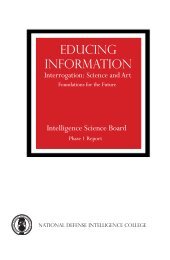Critical Thinking and Intelligence Analysis
Critical Thinking and Intelligence Analysis
Critical Thinking and Intelligence Analysis
You also want an ePaper? Increase the reach of your titles
YUMPU automatically turns print PDFs into web optimized ePapers that Google loves.
partnerships between analysts <strong>and</strong> technology applications. 225<br />
In one<br />
case, a research firm has developed technology that enables analysts<br />
to generate <strong>and</strong> validate novel hypotheses, distill complex systems into<br />
digestible elements, create effective narratives, <strong>and</strong> inspire creative<br />
thinking. 226<br />
Other examples are illustrated in the adjacent text box.<br />
Follow-on research efforts such as the Collaboration <strong>and</strong> Analyst/<br />
System Effectiveness (CASE) effort will develop these efforts further. 227<br />
The intelligence workforce these ARDA-supported efforts presuppose<br />
is being hired <strong>and</strong> trained now.<br />
The future also holds opportunities for further developing<br />
models of reasoning in intelligence. Exactly how analogy <strong>and</strong><br />
critical thinking interact, the roles of creative thinking, the roles<br />
of intuition, <strong>and</strong> specific strategies for bias mitigation are all areas<br />
warranting further research. Formal validation of how critical<br />
thinking improves intelligence reasoning is another research topic.<br />
Rieber <strong>and</strong> Thomason’s proposed National Institute of Analytic<br />
Methods is an obvious venue for such research. Additionally, the<br />
ARDA advanced questioning <strong>and</strong> answering research program,<br />
AQUAINT, as well as other ARDA programs dealing with predictive<br />
analysis, prior <strong>and</strong> tacit knowledge, <strong>and</strong> hypothesis generation offer<br />
other domains in which such research could occur. 228<br />
Such research<br />
is of both intrinsic value <strong>and</strong> necessary for developing new means<br />
225 The five areas on which the NIMD effort focused were modeling analysts<br />
<strong>and</strong> how they work; analysts’ prior <strong>and</strong> tacit knowledge; creating, representing,<br />
<strong>and</strong> tracking multiple scenarios, hypotheses, <strong>and</strong>/or strategies; massive data<br />
management <strong>and</strong> analysis; <strong>and</strong> the means by which analysts interact with<br />
technology. The author represented his agency in evaluating <strong>and</strong> mentoring the<br />
efforts of the researchers.<br />
226 The author is a technical mentor of this firm’s work.<br />
227 For more information, see “Collaboration <strong>and</strong> Analyst/System<br />
Effectiveness (CASE),” AFRL Directorate: IFED BAA 06–02–IFKA, 28 October<br />
2005, URL: , last accessed 11 March<br />
2006.<br />
228 Advanced Research <strong>and</strong> Development Activity (ARDA), “Preliminary<br />
Solicitation Information for Advanced QUestion & Answering for INTelligence<br />
(AQUAINT),” URL: , last accessed 26 March 2006.<br />
– 91 –
















